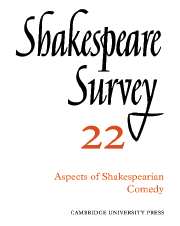Book contents
- Frontmatter
- Old and New Comedy
- An Approach to Shakespearian Comedy
- Shakespeare, Molière, and the Comedy of Ambiguity
- Comic Structure and Tonal Manipulation in Shakespeare and Some Modern Plays
- Laughing with the Audience: ‘The Two Gentlemen of Verona’ and the Popular Tradition
- Shakespearian and Jonsonian Comedy
- Two Magian Comedies: ‘The Tempest’ and ‘The Alchemist’
- ‘Thou that beget’st him that did thee beget’: Transformation in ‘Pericles’ and ‘The Winter’s Tale’
- The Words of Mercury
- Why Does it End Well? Helena, Bertram, and The Sonnets
- Some Dramatic Techniques in ‘The Winter’s Tale’
- Clemency, Will, and Just Cause in ‘Julius Caesar’
- Thomas Bull and other ‘English Instrumentalists’ in Denmark in the 1580s
- Shakespeare in the Early Sydney Theatre
- The Reason Why: The Royal Shakespeare Season 1968
- The Year's Contributions to Shakespearian Study 1 Critical Studies
- 2 Shakespeare’s Life, Times and Stage
- 3 Textual Studies
- Index
- Plate Section
Shakespeare, Molière, and the Comedy of Ambiguity
Published online by Cambridge University Press: 28 March 2007
- Frontmatter
- Old and New Comedy
- An Approach to Shakespearian Comedy
- Shakespeare, Molière, and the Comedy of Ambiguity
- Comic Structure and Tonal Manipulation in Shakespeare and Some Modern Plays
- Laughing with the Audience: ‘The Two Gentlemen of Verona’ and the Popular Tradition
- Shakespearian and Jonsonian Comedy
- Two Magian Comedies: ‘The Tempest’ and ‘The Alchemist’
- ‘Thou that beget’st him that did thee beget’: Transformation in ‘Pericles’ and ‘The Winter’s Tale’
- The Words of Mercury
- Why Does it End Well? Helena, Bertram, and The Sonnets
- Some Dramatic Techniques in ‘The Winter’s Tale’
- Clemency, Will, and Just Cause in ‘Julius Caesar’
- Thomas Bull and other ‘English Instrumentalists’ in Denmark in the 1580s
- Shakespeare in the Early Sydney Theatre
- The Reason Why: The Royal Shakespeare Season 1968
- The Year's Contributions to Shakespearian Study 1 Critical Studies
- 2 Shakespeare’s Life, Times and Stage
- 3 Textual Studies
- Index
- Plate Section
Summary
Exactly three hundred years ago, in September 1668, in the presence of the Russian ambassadors, Molière was performing his great success of that year, Amphitryon, a comedy based on a play of Plautus which, as it happens, Shakespeare had also used in his only imitation of the Latin poet. In the eyes of one who has been invited to speak of Molière on the occasion of a Shakespeare Conference—a rather perplexing privilege—the coincidence is too remarkable not to seem, as Duke Vincentio would say, ‘an accident that Heaven provides’. I see no reason to deny myself the benefit of this happy coincidence, especially since there is much more in common between The Comedy of Errors and Amphitryon than their comparatively unimportant debt to Plautus.
It is currently said that Shakespeare, whose plot is chiefly drawn from the more down-to-earth, naturalistic, Menaechmi, went to the play of Amphitruo for the sake of additional comic effects, the double master-servant theme, and the incident of the husband locked out of his own house. This may be true, but does not invalidate deeper motives. Always a very intelligent reader, he may well have been shrewd enough to recognize that The Menaechmi and Amphitruo are substantially the same kind of story.
- Type
- Chapter
- Information
- Shakespeare Survey , pp. 15 - 26Publisher: Cambridge University PressPrint publication year: 1970

